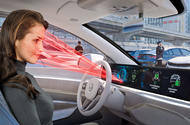Continental’s system is developed with Trinamix and uses 2D recognition
Trinamix Face Authentication identifies owners via facial recognition and can be used for refuelling payments
The latest and what promises to be the most effective method for preventing a bandit from making off with your car is a sophisticated biometric identification system from automotive tech giant Continental.
The same company that produces the tyre brand, Continental is one of the world’s largest automotive tier one suppliers, which means it’s supplying key components directly to the car makers.
The key thing about tier ones like Continental, Bosch, ZF and others is that many of the innovations appearing on cars come from them and not the manufacturer.
This latest system is much the same tech as the facial recognition we use on our mobile phones. Biometrics is the computer science of recognition using biological characteristics.
That may be something as familiar as a fingerprint, or recognising the unique relationship between the structures of the face, iris or retina, veins or a palm print. It can also be applied to recognising movement patterns, such as a person’s gait.
Continental has developed the new system with partner Trinamix and its proprietary technology, Trinamix Face Authentication. The idea is simple. Keys, codes or any other previous methods of securing a car aside, the new tech prevents the car from being driven if it doesn’t recognise the person in the driver’s seat.
On a more positive note, just as you might use your phone to pay when out shopping, it can also be used for making payments via the car display for tolls or buying fuel, including recharging an EV. In addition, Continental sees it being used for app store payments and accessing digital services.
The system is driven by a camera, installed in the instrument display, which will double up to monitor the driver’s attention levels, something that will become mandatory in Europe.
As well as capturing and recognising the unique features and proportions of the driver’s face using 2D recognition, it uses beam profile analysis to avoid being tricked. When the driver gets into the car and attempts to start it, the screen emits an invisible light source illuminating the person’s face with a regular dot pattern.
The reflection of each dot is captured by an infrared camera and the image data analysed by software algorithms. From the beam’s profile, the algorithms can gather information about the surface material of the object (in this case, the driver’s face) it’s measuring. In that way, the system can differentiate between human skin and, say, a 3D silicon mask.
The Trinamix system already meets the security requirements for making payments with Android phones. In external tests, its spoof acceptance rate has always scored a solid zero but, at the same time, it responds in just 250 milliseconds.
As car security has progressed beyond the days of trying to prevent thieves from ripping out steering locks, hard-wiring and cloning keyless entry systems, this latest technology may be the one that, short of kidnapping the driver, finally makes stealing a car in the traditional sense all but impossible.
Start-up extracts lithium from seawater for EV batteries

Saudi Arabian mining company Ma’aden and the King Abdullah University of Science and Technology (KAUST) are investing almost £5 million into a start-up called Lithium Infinity. The company has patented a membrane-based technology to extract lithium directly from sea water. Reserves of lithium in the world’s oceans are put at 230 billion tonnes, compared with 21 million tonnes on land.
Source: Autocar
